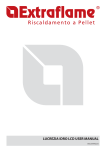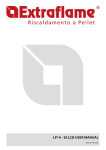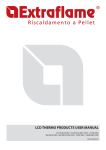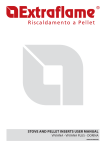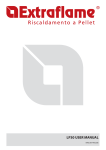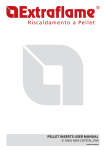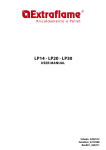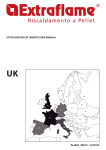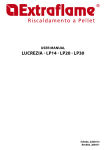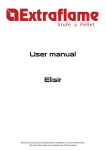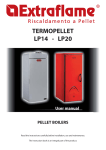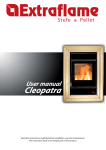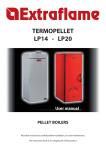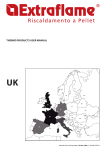Download LP30 USER MANUAL
Transcript
LP30 USER MANUAL ENGLISH/ INGLESE We thank you for having chosen our company; our product is a great heating solution developed from the most advanced technology with top quality machining and modern design, aimed at making you enjoy the fantastic sensation that the heat of a flame gives, in complete safety. Extraflame S. p. A. ENGLISH.....................................................................................................................................................................................................................................5 Technical features............................................................................................................................................................... 5 INTRODUCTION.......................................................................................................................................................................... 6 Warnings................................................................................................................................................................................... 8 Safety......................................................................................................................................................................................... 8 HYDRAULIC SYSTEM................................................................................................................................................................... 9 Installation and safety devices................................................................................................................................................................................. 9 Safety devices for closed vessel system.............................................................................................................................................................. 9 Distances of safety devices according to the Standard......................................................................................................................... 9 Type of system.......................................................................................................................................................................10 Closed vessel SYSTEM .........................................................................................................................................................................................................10 Safety valves............................................................................................................................................................................................................................10 Closed expansion vessel..................................................................................................................................................................................................11 Commissioning checks......................................................................................................................................................................................................11 Automatic thermostatic mixer valve (mandatory)......................................................................................................................................11 Hydraulic system basic layout......................................................................................................................................12 Instant domestic hot water production kit............................................................................................................13 Stove positioning.................................................................................................................................................................................................................13 REARM........................................................................................................................................................................................13 THERMO-PRODUCTS FEATURES.............................................................................................................................................13 Safety devices.......................................................................................................................................................................14 Installation...........................................................................................................................................................................14 Installations allowed.....................................................................................................................................................................................................15 Installations not allowed...........................................................................................................................................................................................15 Connection to the smoke evacuation system..................................................................................................................................................15 Smoke channel or fittings............................................................................................................................................................................................15 Chimney or individual flue............................................................................................................................................................................................16 Chimney cap..............................................................................................................................................................................................................................17 Connection to external air inlets..........................................................................................................................................................................18 Insulation, finishings, covering and safety recommendations.......................................................................................................18 index Pellets and feeding............................................................................................................................................................18 Display icons key...................................................................................................................................................................................................................19 General menu........................................................................................................................................................................20 Basic instructions ..............................................................................................................................................................................................................20 COMMISSIONING settings....................................................................................................................................................21 Adjusting time, day, month and year......................................................................................................................................................................21 Adjusting language...........................................................................................................................................................................................................21 Operation and logic...........................................................................................................................................................22 Additional thermostat ....................................................................................................................................................23 Additional thermostat functioning with stby active.............................................................................................................................23 Additional thermostat installation....................................................................................................................................................................23 3 Menu structure....................................................................................................................................................................24 Set temperature........................................................................................................................................................................................................25 Set power .....................................................................................................................................................................................................................25 Set adjustments .......................................................................................................................................................................................................25 Enable chrono...........................................................................................................................................................................................................25 PELLET ADJUSTMENT...................................................................................................................................................................................................26 user menu......................................................................................................................................................................................................................26 Chrono............................................................................................................................................................................................................................26 Adjusting language...........................................................................................................................................................................................................27 Display.............................................................................................................................................................................................................................27 reset...................................................................................................................................................................................................................................27 Cleaning under user's responsibility.........................................................................................................................28 Routine maintenance ........................................................................................................................................................29 Displays...................................................................................................................................................................................30 ALARMS.....................................................................................................................................................................................31 WARRANTY CONDITIONS........................................................................................................................................................32 index 4 | |ITALIANO ENGLISH Technical features Features LP 30 Weight kg 333 Height mm 1406 Width mm 875 Depth mm 772 Flue exhaust pipe diameter mm 120 Air intake pipe diameter mm 60 Max. global heat output kW 33.8 Max. useful thermal power (to the water) kW 31.1 Minimum global heat output kW 10 Min. useful heat output kW 8.6 Max. hourly fuel consumption kg/h 7.0 Min. hourly fuel consumption kg/h 2.0 l ~ 121 mbar ~ 0.1 W 470 Nominal voltage Vac 230 Nominal frequency Hz 50 Water inlet/outlet pipe diameter “ 1 Automatic exhaust pipe diameter “ 1/2 Pump head m 5 Max. working water pressure accepted bar 2.5 Min. working water pressure accepted bar 0.6 Flue gas temperature °C 69.8 - 105.9 Flue gas flow rate g/s 7.7 - 15.3 Tank volume Recommended flue draught Nominal electric output Boiler class 3 Combustion period h 42 - 12 Water thermostat field of regulation °C 65 - 80 Water return minimum temperature °C 55 mm 576 L x 236 P % 92.0 Flow of water (kg/h) Water side resistance (mbar) ΔT = 10K 2751.6 148 ΔT = 20K 1375.8 74 Dimensions of the feeding door Yield LP30 Corresponding temperature difference 5 | ENGLISH INTRODUCTION The boilers produced in our establishment are built with attention to the individual components so as to protect both the user and the installer from any accidents. It is therefore recommended that after any intervention on the product, that authorised staff pay particular attention to the electric connections, especially the stripped parts of the wires. These must not escape from the terminal board in any situation, thus preventing possible contact with the live parts of the wire. The instruction manual is an integral part of the product: make sure that it always accompanies the appliance, even if transferred to other owners or user or is transferred to another place. If it is damaged or lost,request another copy from the area technician. This boiler must be intended for the use it has been specifically made for. The manufacturer is exempt from any liability, contractual and extracontractual, for injury/damage caused to persons/animals and objects, due to installation, adjustment and maintenance errors and improper use. INSTALLATION Installation of the boiler and auxiliary equipment in relation to the heating system must comply with all current Standards and Regulations and to those envisioned by the law. Installation must be carried out by authorised staff, who must provide the buyer with a declaration of conformity for the system and will assume full responsibility for final installation and as a consequence the correct functioning of the installed product. It is necessary to bear in mind all laws and national, regional, provincial and town council Standards present in the country the appliance has been installed. Extraflame S.p.A. cannot be held responsible for the failure to comply with such precautions. It is recommended to wash all the pipes of the system well before installation to remove any residue that could compromise the correct operation of the appliance. During installation, inform the user regarding: a. If water leaks, he must close the water supply and promptly inform the after-sales technical service. b. The system working pressure must be checked periodically. If the boiler is not used for a long period of time, it is recommended to contact the after-sales technical service to carry out at least the following operations: - Set the master switch to position 0. - Close the water taps of both the heating system and the domestic hot water system. - Empty the heating system and the domestic hot water system if there is risk of freezing. COMMISSIONING After removing the packaging, ensure that the content is intact and complete. Otherwise, contact the dealer where the appliance was purchased from. When commissioning the product, verify that all safety and control devices that the boiler consists of work well. All electrical components that make up the boiler must be replaced with original spare parts exclusively by an authorised technical assistance centre, thereby guaranteeing correct operation. Before leaving the system, the staff in charge of commissioning must monitor boiler operation for at least one complete work cycle. The boiler must be serviced at least once a year, programming it in advance with the technical assistance centre. APPROVALS The Extraflame boilers have been designed and realised in compliance with the following Directives: UNI EN 303-5 Boilers for central heating. Boilers for solid fuel, with manual and automatic feeding, with a nominal heat output of up to 300 kW Compliance with the Low Voltage Directive (73/23 EEC) Compliance with the EMC Directive (Electromagnetic compatibility 89/336 EEC) FOR SAFETY 6 It is forbidden for the boiler to be used by children or unassisted disabled persons. Do not touch the boiler when you are barefoot or when parts of the body are wet or humid. The safety and adjustment devices must not be modified without the authorisation or indications of the manufacturer. Do not pull, disconnect, twist electric cables leaving the boiler, even if disconnected from the electric power supply mains. Do not close or reduce the dimensions of the airing vents in the place of installation. The airing vents are indispensable for correct combustion. Do not leave the packaging elements within reach of children or unassisted disabled persons. The hearth door must always be closed during normal functioning of the product. Avoid direct contact with parts of the appliance that tend to heat up during functioning. Check for the presence of any obstructions before switching the appliance on following a prolonged standstill period. | ENGLISH The boiler has been designed to function in any climatic condition (also critical). In particularly adverse conditions (strong wind, freezing) safety systems may intervene that switch the boiler off. If this occurs, contact the technical after-sales service and always disable the safety system. If the flue should catch fire, be equipped with suitable systems for suffocating the flames or request help from the fire service. If the boiler should block, indicated by a signal on the display and that is not relative to lack of routine maintenance, contact the technical after-sales centre. These boilers must be used to heat water to a temperature that does not exceed boiling point in the conditions of installation. Recommended distances for the boiler compartment B D Below are a few images relative to the minimum distances required in the boiler room. The company recommends the following measurements to be complied with: 780 mm A 875 mm C A E REFERENCES Non-inflammable objects REFERENCES Non-inflammable objects A 500 mm D 300 mm B 1,000 mm E > 80 cm2 C 1,000mm - 7 | ENGLISH Warnings The instruction manual is an integral part of the product: make sure that it always accompanies the appliance, even if transferred to another owner or user or if transferred to another place. If it is damaged or lost,request another copy from the area technician. This product must be intended for the use it has been specifically made for. The manufacturer is exempt from any liability, contractual and extracontractual, for injury/damage caused to persons/animals and objects, due to installation, adjustment and maintenance errors and improper use. Installation must be performed by qualified staff, which assumes complete responsibility for the definitive installation and consequent good functioning of the product installed. It is necessary to bear in mind all laws and national, regional, provincial and town council Standards present in the country the appliance has been installed. Extraflame S.p.A. cannot be held responsible for the failure to comply with such precautions. After removing the packaging, ensure that the content is intact and complete. Otherwise, contact the dealer where the appliance was purchased from. All electric components that make up the product must be replaced with original spare parts exclusively by an authorised aftersales centre, thus guaranteeing correct functioning. Safety The stove must not be used by persons (including children) with reduced physical, sensorial and mental capacities or who are unskilled, unless they are supervised and trained regarding use of the appliance by a person responsible for their safety. Children must be monitored to ensure they do not play with the appliance. Do not touch the stove when you are barefoot or when parts of the body are wet or humid. The safety and adjustment devices must not be modified without the authorisation or indications of the manufacturer. Do not pull, disconnect, twist electric cables leaving the stove, even if disconnected from the electric power supply mains. It is recommended to position the power supply cable in a way that it does not come into contact with hot parts of the appliance. The power supply plug must be accessible after installation. Do not close or reduce the dimensions of the airing vents in the place of installation. The airing vents are indispensable for correct combustion. Do not leave the packaging elements within reach of children or unassisted disabled persons. The hearth door must always be closed during normal functioning of the product. When the appliance is functioning and hot to the touch, especially all external surfaces, attention must be paid Check for the presence of any obstructions before switching the appliance on following a prolonged standstill period. The stove has been designed to function in any climatic condition (also critical). In particularly adverse conditions (strong wind, freezing) safety systems may intervene that switch the stove off. If this occurs, contact the technical after-sales service and always disable the safety system. If the flue should catch fire, be equipped with suitable systems for suffocating the flames or request help from the fire service. This appliance must not be used to burn waste Do not use any inflammable liquids for ignition During the filling phase do not allow the bag of pellets to come into contact with the product The majolicas are top quality artisan products and as such can have micro-dots, crackles and chromatic imperfections. These features highlight their valuable nature. Due to their different dilation coefficient, enamel and majolica produce crackling, which demonstrate their effective authenticity. To clean the majolicas, it is recommended to use a soft, dry cloth. If a detergent or liquid is used, the latter could penetrate the crackles, thereby making them show more. Routine Maintenance Based on the Decree 22 January 2008 n°37 art.2, routine maintenance means interventions aimed at reducing degradation from normal use, as well as dealing with accidental events entailing the need of first interventions, which however do not modify the structure of the system upon which one is intervening or its intended use according to the prescriptions foreseen by technical standards in force and by the manufacturer's use and maintenance booklet. 8 | ENGLISH HYDRAULIC SYSTEM Certain concepts referring to the Italian UNI 10412-2 (2009) Standard are described in this chapter. As previously described, when installing, all national, regional, provincial and town council Standards in force provided by the country in which the appliance has been installed must be complied with. SAFETY DEVICES Table of safety devices for closed vessel system and not present in the product Circuit board: Intervenes directly by sending the product into alarm conditions until complete cooling, in the case of: breakage of flue gas motor, pellet feed motor breakage, black out (if more than 10 seconds), no ignition Safety valve Pump control thermostat (it is managed by the water probe and the board program) Flow sensor: In the event of inadequate flow, it takes the machine to alarm conditions Acoustic alarm activation thermostat F2.5 A 250V fuse (stoves): Protect the machine from violent current drops Water temperature indicator (display) 85°C calibrated mechanical bulb with manual rearm: Intervenes by blocking fuel feed whenever the pellet tank t° reaches the limit of 85°C. Rearm must be performed by qualified staff and/ or the manufacturer's technical after-sales assistance. Pressure indicator 100°C calibrated mechanical bulb with manual rearm: Intervenes by blocking the fuel feed whenever the t° of the water inside the product is near to 100°. Rearm must be performed by qualified staff and/or the manufacturer's technical after-sales assistance. Regulation automatic circuit breaker switch (managed by board program) Minimum and maximum pressure switch: Intervenes in the event of inadequate water pressure. Rearm must be performed by qualified staff and/or the manufacturer's technical after-sales assistance. Water overheating automatic circuit breaker switch (block thermostat) Mechanical air pressure switch: Blocks the pellet in the event of insufficient depression Acoustic alarm Minimum and maximum pressure pressure switch Circulation system (pump) Expansion system R R - R - R R R R R During installation of the stove it is MANDATORY to adjust the system with a manometer in order to display the water pressure. Installation and safety devices The installation, relative system connections, commissioning and inspection of correct functioning must be carried out perfectly, in full compliance with Standards in force, national, regional and municipal, as well as these instructions. For Italy, installation must be carried out by professionally authorised staff (Ministerial Decree dated 22.01.08 n°37). Extraflame S.p.A. declines all responsibility for damage to objects and/or persons caused by the system. Safety devices for closed vessel system According to the UNI 10412-2 (2009) Standard in force in Italy, the closed systems must have: safety valve, pump control thermostat, acoustic alarm activation thermostat, temperature indicator, pressure indicator, acoustic alarm, regulation automatic circuit breaker switch, automatic circuit breaker block switch (block thermostat), circulation system, expansion system, safety dissipation system incorporated with the generator with thermal safety valve (self-activated), whenever the appliance does not have a temperature self-adjustment system. Distances of safety devices according to the Standard The temperature safety sensors must be in place on the machine at a distance no greater than 30 cm from the flow connection. Whenever the generators lack a device, those missing can be installed on the generator flow pipe, within a distance no greater than 1m from the machine. 9 | ENGLISH Component Distance Temperature safety sensors On the machine or not exceeding 30 cm Missing devices because not as per standard Not exceeding one metre, on the flow pipe The domestic heating appliances with automatic feeding must: be supplied with a fuel block thermostat or be supplied with a cooling circuit set-up by the appliance manufacturer. The cooling circuit must be activated by a heat safety valve such to guarantee that the limit temperature set by the Standard is not exceeded. Connection between the power supply unit and the valve must be free from interceptions. The pressure upstream from the cooling circuit must be at least 1.5 bar. Type of system There are two different types of system: Open vessel system and closed vessel system. The product has been designed and realised to work with closed vessel systems. Closed vessel SYSTEM System in which the water it contains is not in direct or indirect communication with the atmosphere. Generally, the closed vessel system has one of the following expansion vessels: Pre-loaded closed expansion vessel with membrane impermeable to the passage of gases. Automatic closed expansion system with compressor and membrane impermeable to the passage of gases. Automatic closed expansion system with transfer pump and membrane impermeable to the passage of gases. Expansion system without diaphragm. Generality The closed systems must have: Safety valve Pump control thermostat Acoustic alarm activation thermostat Temperature indicator Pressure indicator Acoustic alarm Adjustment automatic circuit breaker switch Automatic circuit breaker switch (block thermostat) Circulation system Expansion system Safety dissipation system incorporated with the generator with thermal safety valve (self-activated), whenever the appliance does not have a temperature self-adjustment system Safety valves The load capacity of the safety valve must allow the discharge of a quantity of vapour, not lower than: Q / 0.58 [kg/h] where: Q is the useful outlet power to the generator water expressed in kilowatt. The diameter of the minimum net transversal section of the valve inlet must not be lower than 15 mm. The valve load pressure, equal to the calibration pressure, increased by the overpressure, cannot exceed the maximum exercise pressure of the heat generator. The designer must check that the maximum pressure existing in every point of the system, does not exceed the maximum exercise pressure of its every component . The safety valve must be connected to the highest part of the heat generator or outlet pipes, immediately near the generator. The length of the pipes route included between the attachment to the generator and the safety valve must not be more than 1 m. The connection piping of the safety valve to the heat generator must not be traceable and must not present, in any point, a 10 | ENGLISH smaller section than the inlet of the safety valve or the sum of the inlet sections in case of more valves heading a single pipe. The discharge piping of the safety valve must be realised in order not to prevent the regular functioning of the valves and not to cause damages to persons; the discharge must flow immediately near the safety valve and be accessible and visible. The diameter of the discharge piping must not however be lower than that of the outlet connection of the safety valve. For diameter of outlet connection it is intended the minimum internal diameter on the valve outlet upstream of the eventual internal threading. Closed expansion vessel Warnings: check that the preload of the expansion vessel is set to 1.5 bar. The vessel maximum exercise pressure must not be lower than the calibration pressure of the safety valve, increased by overpressures, characteristic of the same valve, bearing in mind the eventual level difference between vessel and valve and the pressure generated by the functioning of the pump. The capacity of the expansion vessel/s is evaluated depending on the total system capacity as results from the project. The closed expansion vessels must comply with the dispositions regarding the planning, manufacturing, evaluation of conformity and use for pressure appliances. Intercepting objects or section decreases must be inserted/practiced on the connection piping, which can be constituted by system portions. The insertion of a threeway intercepting valve which allows connection between the vessel and the atmosphere for maintenance operations, is allowed. Such device must be protected against accidental manoeuvres. The connection pipe must be realised in order not to present scales or deposits storage points. In case of more heat generators which feed the same system or the same secondary circuit, each heat generator must be connected directly to the expansion vessel or system expansion vessels unit, altogether dimensioned for the total volume of water contained in the same system or the same independent circuit. Where it is necessary to separate the individual heat generator from the expansion vessel or expansion vessels unit, a three-way tap must be applied on the connection piping between the generator and the vessel, in order to ensure, in every position, the connection of the generator with the expansion vessel or with the atmosphere. The expansion vessels, the connecting pipes, the bleed pipes and drain pipes must be protected from freezing, where this phenomenon occurs. The solution used for this purpose is described in the design. Commissioning checks Before connecting the boiler: a) wash all system piping in order to remove any residues which might compromise the correct functioning of certain system components (pumps, valves, etc.). b) check to verify that the flue has adequate draft, is not narrowed and that other appliances do not discharge into the flue. This is to prevent unexpected power increases. Only after this control can the flue fitting be mounted between the boiler and the flue. A check of the connections with pre-existing flues is recommended. Automatic thermostatic mixer valve (mandatory) The automatic thermostatic mixing valve finds applications in solid fuel boilers as it prevents cold water return into the exchanger. 3 Routes 1 and 3 are always open and, together with the pump installed on the return, they guarantee water circulation inside the biomass boiler exchanger. An elevated return temperature, allows efficiency improvement, reduces formation of combustion product condensation and prolongs the boiler life span. Valves on the market have different calibrations. Extraflame advises use of 55°C model with 1" hydraulic connections. Once the valve calibration temperature is reached, route 2 is opened and the boiler water goes to the system via the flow. 2 1 Valve sold as an accessory (optional) 11 | ENGLISH Hydraulic system basic layout NOTA BENE: the drawing in the figure is an example. S M T T1 T2 VB T3 AUX B STBY G A 1 3 2 VMTA SI Key A Primary air inlet Ø 60mm B Smoke exhaust outlet Ø 120mm C Pump (in the models envisioned) 1/2 " T1 3 bar safety drain 1/2 " T2 Boiler flow/output 1" T3 Boiler return/inlet 1" M Manometer T Thermometer G Filling system S Safety valve discharge VB Balance valve YES System exhaust VMTA Thermostatic mixer valve 55°C It is recommended to consult the templates manual at for further information relative to the hydraulic connections, air intake/flue exhaust and dimension specifications of the product in question. 12 | ENGLISH Instant domestic hot water production kit Warnings: if the instant hot water production kit is to be used, contact the company technical after-sales service. Stove positioning For correct product functioning, it is recommended to position it in a way that it is perfectly level, with the aid of a spirit level. REARM The figures below show the rearm positions of the tank (85°C) and H2O (100°C). It is recommended to contact the qualified technician if one of the rearms should be triggered, so as to verify the cause. 85°c 100°C AUX STBY THERMO-PRODUCTS FEATURES lp30 Water content of the thermo product heat exchanger (l) Volume of expansion vessel integrated into thermo-product (l) Maximum content of water in the system for integrated expansion vessel (l)* 3 bar safety valve integrated into the thermo-product Minimum and maximum pressure switch integrated into the thermo-product Pump integrated into the thermo-product Pump max. head (m) 66 12 170 YES YES YES 5 6 The diagram at the side illustrates the behaviour of the pump used on our thermo-products at the speeds that can be set. Head (m) 5 *Content of water in the system in addition to that of the thermo product that can be managed with the integrated expansion vessel. An additional expansion vessel must be installed for a higher content of water. 4 3 2 1 0 0,0 0,5 1,0 Flow rate (m3/h) 1,5 2,0 2,5 13 | ENGLISH SAFETY DEVICES Key: * = present, - = not present Circuit board: intervenes directly by sending the product into alarm conditions until complete cooling, in the case of: breakage of flue gas motor, pellet feed motor breakage, black out (if more than 10 seconds), no ignition STOVES Safety devices * * F 2.5 A 250 V fuse (stoves): protects the machine from violent current drops * 85°C calibrated mechanical bulb with manual rearm: intervenes by blocking fuel feed whenever the pellet tank t° reaches the limit of 85°C. Rearm must be performed by qualified staff and/or the manufacturer's technical after-sales assistance. * Pellet feed-box temperature control probe: if the tank over-heats, the machine automatically modulates to return * to normal temperature values (* in the models envisioned) Mechanical air pressure switch: blocks the pellet in the event of insufficient depression (in the models envisioned) * Installation The installation must be in compliance with: UNI 10683 (2005) heat generators fed with wood and other solid fuels: installation. The chimneys must be in compliance with: EN 13384 Thermal and fluid dynamic calculation methods. UNI 1443 (2005) chimneys: general requirements. UNI 1457 (2012) chimneys: clay/ceramic flue liners. UNI/TS 11278 (2008) Chimneys/smoke channels/pipes/ flues/metal pipes. UNI 7129 point 4.3.3 Fire Department dispositions, local rules and prescriptions. National, regional, provincial and town council regulations It is necessary to bear in mind all laws and national, regional, provincial and town council Standards present in the country the appliance has been installed. 14 CLOSED HEARTH APPLIANCE Heat generator which opening is only allowed through the loading of the fuel during use. BIOMASS Biological material, excluding the material incorporated in geological formations and transformed into fossils. BIOFUEL Fuel produced directly or indirectly by biomass. Door micro switch: With the door open, burn pot system operation is blocked Electronic pressure switch: in the event of inadequate depression, it takes the machine to alarm conditions Glossary CHIMNEY Vertical pipe with the aim of collecting and expelling the fuel products coming from only one appliance, at a convenient height from the ground. SMOKE CHANNEL OR FITTING Pipe or connecting element between heat generator appliance and chimney to evacuate combustion products. INSULATION Group of set-ups and materials used to prevent the transmission of heat through a wall that separates rooms with different temperatures. CHIMNEY CAP Device positioned at chimney peak to ease the dispersion of combustion products into the atmosphere. CONDENSATE Liquid products that form when the combustion gas temperature is lower or equal to the water dew point. HEAT GENERATORS Appliance which allows to produce thermal energy (heat) through the rapid transformation, via combustion, of the chemical energy of the same fuel. GATE VALVE Mechanism for modifying the combustion gas dynamic resistance. COMBUSTION PRODUCT EVACUATION SYSTEMS Flue gas exhaust system independent from the appliance constituted by a fitting or smoke channel, chimney or individual flue and chimney cap. FORCED DRAUGHT Air circulation by means of the fan activated by electric motor. NATURAL DRAUGHT Draught which is determined in a chimney/flue for effect of the volume mass difference existing between smoke (hot) and surrounding atmosphere air, without any mechanical intake aid installed inside it or at its peak. | ENGLISH RADIATION AREA Area immediately near the hearth in which the heat caused by combustion is diffused, where no combustion materials must be present. REFLUX AREA Area where leaking of the combustion products is verified, from the appliance towards the installation room. The installation must be preceded by checking the chimneys, flues or unload terminals positioning of appliances similarly to: Installation prohibitions Legal distances Limitations disposed by local administrative regulations or particular authority prescriptions. Conventional limitations deriving from condominium regulations, constraints or contracts. Installations allowed Only appliances working in a sealed manner respect to the room or which do not place the room in depression respect to the external environment, can exist or be installed in the room where the heat generator will be installed. Appliances for cooking food and relative hoods without extractor are only allowed in kitchens. Installations not allowed In the room where the heat generator will be installed the following must not pre-exist or be installed: hoods with extractor collective type ventilation pipes. Should these appliances be in rooms adjacent, communicating with the installation room, the simultaneous use of the heat generator is forbidden, where a risk exists of one of the two rooms being placed in depression respect to the other. Connection to the smoke evacuation system UNI 10683 (2005) Standard for expelling combustion products, the instructions below must be followed: Insulating product < 45° < 45° Flue pipe Inspection The horizontal routes will have to have a minimum upward slope of 3% The length of the horizontal route must be minimal and, however, not longer than 3 metres The number of direction changes including the one for effect of using the "T" element must not be more than 4. In any case, the smoke channels must seal the combustion and condensate products and be insulated if they pass outside the installation room. The use of counterslope elements is forbidden. The smoke channel must allow the recovery of soot or be brushable. The smoke channel must have constant section. Any section changes are only allowed at the flue coupling. It is forbidden to have other air supply channels and pipes for system engineering, especially if over-sized, transit inside the smoke channels. The mounting of manual draught adjustment devices on forced draught appliances is forbidden. Smoke channel or fittings To mount the smoke channels, non-flammable elements will have to be used, ideal for resisting combustion products and their eventual condensing. The use of flexible metal and asbestos cement pipes to connect the appliances to the flue is forbidden, even for preexisting smoke channels. There must be continuity between the smoke channel and the flue so that the flue does not lean on the generator. The smoke channels must not cross rooms where the installation of the combustion appliances is not allowed. The mounting of the smoke channels must be carried out in order to guarantee smoke seal for the appliance functioning conditions, limit the forming of condensate and avoid it being transported towards the appliance. The mounting of horizontal routes must be avoided. For appliances where ceiling or wall non-coaxial discharges with respect to the appliance combustion product outlet have to be reached, the direction changes will have to realised using open bends not greater than 45° (see figures below). For the heat generator appliances equipped with electric fan 15 | ENGLISH Chimney or individual flue The chimney or individual flue must respond to the following requisites: seal the combustion products, be waterproof and adequately insulated in line with the use conditions; be realised with materials which resist the normal mechanical stress, heat, action of the combustion products and any condensate; have mainly vertical progress with deviations from the axis not higher than 45°; be adequately distanced from fuel or flammable materials through air space or opportune insulation; have preferably circular internal section: the square or rectangular sections must have round corners with a radius not lower than 20 mm; have constant internal section, free and independent; have rectangular section with max. ratio between the sides of 1.5. It is recommended that the smoke pipe be equipped with a collection chamber for solid materials and any condensate situated under the smoke channel inlet, so that it can be easily opened and inspected from airtight door. REFERENCES A B C Inflammable objects 200 mm 1,500 mm 200 mm Non-inflammable objects 100 mm 750 mm 100 mm Minimum 80 cm2 S= floor protection Flue Air inlets C B A Inspection S Chimney cap windproof <3m 3-5% Inspection Flue Inspection 16 | ENGLISH <3m External pipe that is isolated 45° 45° Inspection Inspection Appliance connection to the flue and combustion products evacuation The flue must receive the discharge from only one heat generator. Direct discharge towards closed spaces is forbidden, even with clear sky. The direct discharge of the combustion products must be at roof and the smoke pipe must have the features provided in the "Chimney or individual flue" section. Chimney cap The chimney cap must comply with the following requisites: have an internal section equivalent to that of the chimney; have useful outlet section not lower than double the chimney internal section; be built in order to avoid rain, snow, foreign bodies penetrating the chimney and so that, in the event of winds in any direction and inclination, the discharge of the combustion products is assured. be positioned in a way to guarantee an adequate dispersion and dilution of the combustion products and, however, outside the reflux area in which the formation of counterpressures occurs. Such area has different dimensions and configuration depending on the covering inclination angle. It is therefore necessary to adopt the minimum heights indicated in the figure layouts below. The chimney cap must not have mechanical intake means. SLOPING ROOF FLAT ROOF >A 50 cm <A 50 cm <5m >5m <5m >50 cm H min Z β Z=REFLUX AREA 17 | ENGLISH Connection to external air inlets The appliance must be able to use the necessary air to guarantee regular functioning through external air inlet. The air inlets must comply with the following requisites: have a total free section of at least 80 cm². must be protected by grates, metal net or suitable protections as long as they do not reduce the minimum section stated in the previous point and positioned in order to avoid them being obstructed. If the combustion agent air is withdrawn directly from outside through a pipe, a downward bend must be mounted outside or a protection against the wind and no grates or similar must be positioned, (it is recommended that the air vent always communicates directly with the installation room even if the air is withdrawn from outside through a pipe). The air flow can also be obtained from an adjacent room, as long as the flow takes place freely through permanent openings communicating with the outside. The adjacent room, with respect to the installation room, must not be put in depression with respect to the external environment by means of reverse draught caused by the presence of another used appliance or intake device in such room. The permanent openings in the adjacent room must comply with the above-described requisites. The adjacent room cannot be set up as garage, storage for combustion material or activity with danger of fire. Insulation, finishings, covering and safety recommendations The coverings, independently from the materials from which they are made, must constitute a self-supporting construction with respect to the heating block and not be in contact with it. The cross members and finishings in wood or combustion materials must be positioned outside the hearth radiation area or adequately insulated. If coverings in combustion material or sensitive to heat exist in the space above the generator, an insulating and non combustible protection diaphragm must be inserted. Elements in combustible or inflammable material like wooden furniture, curtains, etc. directly exposed to the hearth radiation, must be positioned at a safe distance. The appliance installation must guarantee easy access for cleaning the appliance itself, discharge gas pipe and flue. CHIMNEY CAPS, DISTANCES AND POSITIONING Roof inclination Distance between the ridge and the chimney Minimum chimney height (measured from outlet) β A (m) H (m) < 1,85 > 1,85 < 1,50 > 1,50 < 1,30 > 1,30 < 1,20 > 1,20 0.50 m over the ridge 1.00 m from roof 0.50 m over the ridge 1.30 m from roof 0.50 m over the ridge 2.00 m from roof 0.50 m over the ridge 2.60 m from roof 15° 30° 45° 60° Pellets and feeding The pellets used must comply with the features described by the Standard: Ö-norm M 7135 DIN plus 51731 UNI CEN/TS 14961 Extraflame recommends the use of pellets with use pellet having a 6 mm diameter. Open the tank lid and load the pellets using a scoop. THE USE OF BAD QUALITY PELLETS OR ANY OTHER MATERIAL CAN DAMAGE YOUR STOVE AND WILL MAKE THE WARRANTY NULL AND VOID, RELEASING THE MANUFACTURER FROM ANY LIABILITY. 18 | ENGLISH STBY SABATO 29 / 09 /2012 18 : 56 4 85°C Boiler H2O Temperature ON/OFF BUTTON day, date, time + 2 1 Real power Set power 3 Key to go back to the previous Menu Encoder (wheel) By turning and/or pressing it one Accesses the Menus. + + + ++ - - - -set Temperature set power set adjustments set status set user set installer Display icons key It indicates weekly programming operation Hand indicator = weekly programming disabled It indicates pump operation STBY Off = pump deactivated On = pump active Flashing = the safety device is active (H2O temperature > 85°C) Chrono indicator = weekly programming active STBY STBY Indicates the contact of the external additional thermostat Closed contact = the contact of the external additional thermostat is closed. Open contact: the contact of the external additional thermostat is STBY open. Extraflame has an optional additional board that allows the boiler the following further functions when managing the system. The table below indicates the various possibilities that the optional can offer. DHW Storage Management * Puffer Management * 3 heating areas * Instant DHW option * Puffer pump or 4th heating area management * Anti-legionella management for DHW storage * DHW storage chrono management * Auxiliary output management and control * 19 | ENGLISH General menu STBY 1 on/off - menu exit. 2 Press to access the Menu. Turn to: select, access, modify. Press to memorise. 3 Go back to the previous menu. SABATO 29 / 09 /2012 18 : 56 85°C - + 4 set h2o Set temperature 2 Set power 2 Set adjustments enable chrono 2 2 Status STOVE STATUS pellets 2 set clock User menu 2 2 2 2 Technic set (Reserved to the qualified technician) Basic instructions The following recommendations must be followed the first times the stove is ignited: It is possible that slight odours are produced due to the drying of the paints and silicones used. Do not remain in the environment for long periods. Do not touch the surfaces as they could still be unstable. Air the room well several times. The hardening of the surfaces is terminated after several heating processes. This appliance must not be used to burn waste. set chrono language display 2 reset Before lighting the stove, the following points must be verified: The hydraulic system must be completed in compliance with the guidelines of the regulations and the manual. The tank must be full of pellets The combustion chamber must be clean The burn pot must be completely free and clean Check the hermetic closure of the fire door and the ash drawer Check that the power supply cable is connected correctly The bipolar switch in the rear right part must be positioned on 1. DO NOT USE ANY INFLAMMABLE LIQUIDS FOR IGNITION! DO NOT ALLOW THE BAG OF PELLETS TO COME INTO CONTACT WITH THE BOILING HOT STOVE DURING THE FILLING PHASE! In the event of continuous no ignition, contact an authorised technician. 20 | ENGLISH COMMISSIONING settings Once the power cable at the back of the stove has been connected, move the switch, also located on the back, to (I). The switch at the back of the stove powers the stove board. The stove remains off and a first screen appears on the panel reading OFF . Adjusting time, day, month and year Set clock allows to adjust the time and date Controls procedure From the main screen, turn P2 to select the icon Press P2 to confirm Turn P2 to select “SET CLOCK” Confirm, pressing P2 Turn P2 to select the desired parameter Press P2 to enter modification mode Turn P2 to modify the value Press P2 to confirm and exit If you wish to exit without memorising, press key P1 set clock DAY HOURS MINUTES DATE MONTH YEAR SATURDAY 23 21 04 06 12 Adjusting language The boiler allows to set the following languages: Italian, English, French, German and Spanish ITALIAN is the default setting Controls procedure Turn P2 to select the icon Press P2 to confirm Turn P2 to select “LANGUAGE” Confirm, pressing P2 Turn P2 to select the desired parameter Press P2 to enter modification mode Turn P2 to modify the value Press P2 to confirm and exit If you wish to exit without memorising, press key P1 LANGUAGE ENGLISH Burn pot cone IT IS PROHIBITED to use the appliance without the burn pot cone (see figure to the side). In the case of wear or deterioration request after-sales assistance for replacement of the part (replacement that is not under guarantee as the component is subject to wear). clean check up 1 - 2 BURN POT BOTTOM J Should the "clean check up" alarm be triggered, make sure that the bottom of the burn pot is free of residues or scales. The holes at the bottom must be completely free to guarantee correct combustion. (See chapter “cleaning carried out by the user”) one can use the function "Pellet feed adjustment" to adjust combustion according to the described requirements. If the alarm persists and the above listed conditions have been checked, contact the qualified after-sales assistance centre. 21 | ENGLISH Operation and logic Ignition Once the points listed previously have been checked, press key 1 for three seconds to ignite the stove. 15 minutes are available for the ignition phase. After ignition and having reached the control temperature, the stove interrupts the ignition phase and passes to STARTING. Starting During the start-up phase, the stove stabilises combustion, increasing it progressively, to then start ventilation and pass on to WORK. Work During the work phase, the stove reaches the set power; see following item. Adjusting power setting Set the operating power (from 1 to 5) . Power 1 = minimum level - Power 5 = maximum level. H2O temperature SET adjustment Set the boiler temperature from 65 - 80°C . Pump operation The pump activates water circulation when the t° of the water inside the stove reaches 60°C. As the pump always functions above 60°, an always open heating area is recommended to make product functioning homogenous, preventing overheating blocks. Normally this area is defined “Safety zone”. Burn pot cleaning At pre-set intervals the stove performs burn pot cleaning, switching the machine off. When the cleaning phase is finished, the stove will re-start automatically and continue its work going back to the selected power level. MODULATION and H-OFF As the water temperature approaches the set point, the boiler starts to modulate automatically bringing itself to the minimum power. If the temperature increases beyond the set point, it will automatically switch off indicating H-off and will automatically go back on when the temperature drops below the set point. Switch-off Press key 1 for three seconds. When the operation has been performed, the appliance automatically enters the switch- off phase, blocking the supply of pellets. The flue gas exhaust motor will remain on until the stove temperature has dropped below the factory parameters. Re-ignition The stove can only be re-ignited automatically or manually when the cooling cycle conditions and the preset timer have been satisfied. No ignition First ignition could even fail as the auger is empty and is not always able to load the burn pot with the required amount of pellets on time to regularly start the flame. J Wait for the machine to cool down (green screen) Press key 1 for 3 seconds If the problem occurs after only a few months working, check that routine cleaning stated in the stove booklet, has been carried out correctly. 22 | ENGLISH Additional thermostat There is a possibility to thermostat a room adjacent to the room where the stove is positioned: just connect a thermostat following the procedure described in the next step (it is recommended to position the optional mechanical thermostat at a height of 1.50 m from the floor) . The default STBY function is always active (it cannot be disabled) and the STBY clamp is jumpered (contact closed). Additional thermostat functioning with stby active When the contact or external thermostat is not satisfied (open contact STBY =temperature reached), the stove will switch off. STBY As soon as the contact or external thermostat switches to the "not satisfied" status (closed contact = temperature to be STBY STBY reached) it will re-ignite, after the boiler has cooled down. N.B.: stove operation depends on the temperature of the water inside the stove and relative factory setting restrictions. If stove is in H OFF (water temperature reached), any additional contact or thermostat request will be ignored. Additional thermostat installation Switch the appliance off using the master switch positioned on the rear of the stove. Remove the plug from the socket. Refer to the electrical diagram to connect the two thermostat cables onto the relative clamps positioned on the rear of the machine, one is red and the other one is black (STBY clamp). The STBY and AUX clamps can be noted in the image below. The image is given as an example. AUX STBY Attention: The clamp must be fitted with a "dry" type contact (Input with dry contact, potential-free) J N.B. : Installation must be performed by an authorised technician 23 | ENGLISH Menu structure STBY on/off - menu exit. 2 Press to access the Menu. Turn to: select, access, modify. Press to memorise. 3 Go back to the previous menu. SABATO 29 / 09 /2012 18 : 56 85°C - 2 1 + 4 Menu set temperature set h2o TEXT 65 - 80°C VALUE set power Power 01 - 05 2 set adjustments Enable chrono pellets 2 status 1 and 2 2 Set Clock user menu Set chrono Reset -30... +20% Selecting the power Activation / deactivation weekly programmer Selecting the percentage of pellet feed References reserved to the technician Day Hours Minutes Date Month Year Enable chrono Start - prg1 Stop - prg1 Monday prg1 off Sunday prg1 off Set prg1 Start - prg2 00:10 Stop - prg2 00:10 Monday prg2 off Sunday prg2 off Set prg2 Start - prg3 00:10 Stop - prg3 00:10 Monday prg3 off ...Sunday prg3 off Set prg3 Start - prg4 00:10 Stop - prg4 00:10 Monday prg4 off ...Sunday prg4 off Set prg4 Language ital - engl - deut - fran - espa Display Display 24 on - off FUNCTION Selection of the boiler temperature set-point Reset mon...sun 00...24 00...59 1...31 1...12 00...99 Off OFF - 00:00 OFF - 00:00 ON / OFF 65 - 80°C OFF - 00:00 OFF - 00:00 ON / OFF 65 - 80°C OFF - 00:00 OFF - 00:00 Setting the day of the week Adjustment of the hour Adjustment of the minutes Adjustment of the date Adjustment of the month Adjustment of the year Activation/deactivation of the weekly programmer 1st ignition time 1st switch-off time Ignition/switch-off consents for various days Temperature setting for the 1st time span 2nd ignition time Time 2nd switch-off time Ignition/switch-off consents for various days Setting room temperature for the 2nd time slot 3rd ignition time 3rd switch-off time ON / OFF Ignition/switch-off consents for various days 65 - 80°C OFF - 00:00 OFF - 00:00 Setting room temperature for the 3rd time slot 4th ignition time 4th switch-off time ON / OFF Ignition/switch-off consents for various days 65 - 80 °C Setting room temperature for the 4th time slot off - ON Delayed switch off of the backlighting ON / OFF Resets the values modifiable by the user back to the default values. Selecting the language | ENGLISH Set temperature The following menu allows the boiler temperature to be set The possible settings are: 65 - 80°C. set h2o Controls procedure 76 c From the main screen, turn P2 to select the set temperature icon Press P2 to confirm Turn P2 to adjust the temperature Confirm and memorising by pressing P2 To exit without memorising, press key P1 ° + Set power - The following menu allows to set the power. Minimum power 1, maximum power 5. Controls procedure - From the main screen, turn P2 to select the set temperature icon Press P2 to confirm Turn P2 to adjust the power Confirm and memorising by pressing P2 To exit without memorising, press key P1 + 05 Set adjustments The set user menu offers the following possibilities automatic/manual mode: allows enabling/disabling the chrono inside the boiler pellet adjustment: allows pellet adjustment Enable chrono The boiler chrono can be enables/disables from this menu Controls procedure From the main screen, turn P2 to select the SET ADJUSTMENTS icon Press P2 to confirm Turn P2 to take chrono enabling to ON Confirm and memorising by pressing P2 To exit without memorising, press key P1 enable chrono ON 25 | ENGLISH PELLET ADJUSTMENT The following menu allows to adjust the percentage of pellet feed. If the stove has functioning problems owing to the quantity of pellets, adjust pellet feeding directly from the control board. The problems correlated to the amount of fuel can be divided into 2 categories: No fuel: the stove can never develop a suitable flame, tending to remain very low even at high powers. at minimum power the stove tends to almost switch-off taking the stove into “no pellets” alarm condition. when the stove displays the “no pellets” alarm, there may be non-burned pellets inside the burn pot. Excess fuel: the stove develops a very high flame even at low power. the panoramic glass is very dirty, obscuring it almost totally. the burn pot tends to become encrusted, blocking the holes for air intake due to the excessive pellet feed, as it is only burned partially. The adjustment to be performed is in percentage. Therefore a modification of this parameter will lead to a proportional variation of all stove feeding speeds. Feeding is from -30% to +20%. Controls procedure pellet adjustment From the main screen, turn P2 to select the SET ADJUSTMENTS icon Press P2 to confirm and successively press P2 again to select PELLET REGULATION Turn P2 to modify the parameter as a percentage (-30/+20) Confirm and memorising by pressing P2 to exit without memorising, press key P1 - + 00 user menu set clock see chapter: commissioning settings Chrono The chrono allows to program 4 time spans within a day to use every day of the week. The switch-on and switch-off time can be set in every time slot, along with the days of use of the programmed time slot and the desired water temperature (65 - 80°C). Recommendations The ignition and switch-off times must be within the space of one day, from 0 to 24 and not over several days: Before using the chrono function, set the current day and time. Then check that the points listed in the “Set clock” sub-chapter have been followed, so that the chrono function works. Aside from programming it, activate it as well. Example Switch-on time 07:00 Switch-off time 18:00 Switch-on time 22:00 Switch-off time 05:00 J 26 CORRECT INCORRECT To enable the chrono follow the instructions as described in the "enable chrono" chapter. When the weekly Programmer is active, the relevant icon will light up on the control panel | ENGLISH Screen Entry and Explanation Controls procedure Turn P2 to select the icon Press P2 to confirm Turn P2 to select “SET CHRONO” Confirm, pressing P2 Turn P2 to select the desired parameter Press P2 to enter modification mode Turn P2 to modify the value Press P2 to confirm and exit If you wish to exit without memorising, press key P1 SCREEN START PRG1 STOP PRG1 MONDAY PRG1 TUESDAY PRG1 WEDNESDAY PRG1 THURSDAY PRG1 FRIDAY PRG1 SATURDAY PRG1 SUNDAY PRG1 SET PRG1 00:00 00:00 ON OFF OFF OFF OFF OFF OFF 75°C set chrono START PRG1 STOP PRG1 MONDAY PRG1 ... Explanation First time slot ignition time First time slot switch-off time Day allowed or not (on - off ) Day allowed or not (on - off ) Day allowed or not (on - off ) Day allowed or not (on - off ) Day allowed or not (on - off ) Day allowed or not (on - off ) Day allowed or not (on - off ) Setting water t° Adjusting language • see chapter: commissioning settings Display Activating OFF, the back light of the display will go off after a preset delay. The back light will go on as soon as a key is pressed or if an alarm should be triggered in the machine. Controls procedure Turn P2 to select the icon Press P2 to confirm Turn 2 to select “display” Confirm, pressing P2 Turn 2 to select on - OFF Press P2 to confirm and exit If you wish to exit without memorising, press key P1 display display off reset Allows to reset all values modifiable by the user to the default values. Controls procedure Turn P2 to select the icon Press P2 to confirm Turn 2 to select “reset” Confirm, pressing P2 Turn 2 to select on Press P2 to confirm The display will show "done" to confirm the command. reset Reset on 27 | ENGLISH Cleaning under user's responsibility Some images could be offset from the original model. DAILY Burn pot: The burn pot is cleaned via a mechanical system at pre-fi xed intervals automatically by the boiler. The fi gure below shows the burn pot with underlying opening. The company recommends the removal of ash deposits using a suction device at least once every two days, or however, on the basis of use of the product. WEEKLY Cleaning the ash drawer: Empty the ash drawer every week or when required. It is therefore recommended to remove the ash in the combustion chamber at least once a week using a suitable suction device. 28 | ENGLISH Routine maintenance In order to guarantee proper functioning and safety of the device, the operations indicated below must be performed every season or more often when necessary. DOOR, ASH DRAWER AND BURN POT GASKETS The gaskets guarantee the tightness of the stove and its consequent good functioning. These must be checked regularly: if they should be worn or damaged they must be replaced immediately. These operations must be carried out by a qualified technician. Connection to the flue Suck and clean the pipe that leads to the flue yearly or anytime that it is necessary. If there are horizontal tracts the residues must be removed before they can obstruct flue passage. NON-CLEANING jeopardises safety. If the power supply cable is damaged, it must be replaced by the after-sales service or by a similarly qualified person, so as to avoid al risks. For correct functioning, the stove must undergo routine maintenance by a qualified technician, at least once a year. Make sure that the ash is completely cold before emptying it into a suitable container. * The “Chimney sweep” bin is an accessory available from the company. D C B C B A Fumes motor (disassembly and cleaning and fumes pipe and "t"), new silicone in the provided points B Inspections of gaskets, ash drawer and door (replace them and apply silicone where envisioned) C Combustion chamber and heat exchanger (full cleaning) including ignitionplug pipe D Feed box (complete emptying and cleaning). E Check air intake pipe and cleaning of the flow sensor A B 29 | ENGLISH Displays Display Off START PELLET FEEDING Stove off The start-up phase is in progress Continuous pellet feeding is in progress during the ignition phase Ignition The ignition phase is in progress Start-up The start-up phase is in progress Work Modulation Burn pot cleaning Final cleaning The normal work phase is in progress The stove is working at minimum Automatic burn pot cleaning is in progress The final cleaning is in progress Stand-by Stove off waiting for re-ignition due to an external thermostat The stove will only re-start when the external thermostat makes a request COOLING STAND-BY A new ignition is attempted when the stove has just been switched off. When the stove switches off, one must wait for the complete shutdown of the fumes motor, then clean the burn pot. The stove can only be re-ignited when these operations have been performed. Hoff BLACK OUT STAND-BY Anti-freeze Antilock Auto blow Exchanger block 30 Reason Stove off due to water temperature over set As soon as the water temperature drops below the pre-set parameters, the stove will switch back on The stove is cooling after a power cut. Once cooling is completed it will re-start automatically The anti-freeze function is in progress as the H2O t° is below the factory set threshold the pump is active until the water reaches the pre-set factory parameter +2°C The pump antilock function is in progress (only if the stove has been in an OFF state for at least 96 hours); the pump is activated for the time pre-set by the manufacturer, in order to prevent it from blocking The automatic blow is active Automatic exchanger cleaning is blocked | ENGLISH ALARMS When the boiler goes into alarm mode, the screen becomes red and does not accept commands outside the display. When the screen turns green, “ALARMS MEMORY” will be displayed with the type of alarm and the boiler can respond to external controls. If the alarm can be solved by the user, once this has been performed the boiler can be re-ignited by pressing key 1. In the event of a more complex alarm, contact the after-sales assistance. STBY SABATO 29 / 09 /2012 18 : 56 ACTIVE ALARM STBY SABATO 29 / 09 /2012 18 : 56 ALARM MEMORY "ALARM TYPE" - Aspiration fault + - + Fumes motor fault Contact after-sales centre Fumes probe failure. Contact after-sales centre High flue gas temperature Check pellet feed (see “Pellet feed adjustment”). If the problem cannot be solved, contact an authorised technician. The door is not closed correctly. The ash drawer is not closed correctly. The combustion chamber is dirty. The flue exhaust pipe is blocked. Check hermetic door closure. Check hermetic closure of the ash drawer. Check cleanliness of the fumes pipe, of the sensor in the primary air channel and the combustion chamber. The pellet feed-box is empty. Pellet feed calibration inadequate. Check for the presence of pellets in the feed-box. Adjust pellet flow (see “Pellet feed adjustment”). Check the procedures described in the “Ignition” chapter. No ignition Black out No current during the ignition phase. Take the stove to off conditions using key 1 and repeat the procedure described in the "Ignition" chapter. No pellets The pellet feed-box is empty. No pellet feed. The motor reducer does not feed pellets. Check for the presence of pellets in the feed-box. Adjust the pellet flow (see “Pellet feed adjustment”). The door is not closed correctly. The ash drawer is not closed correctly. The combustion chamber is dirty. The flue exhaust pipe is blocked Check hermetic door closure. Check hermetic closure of the ash drawer. Check cleanliness of the fumes pipe and the combustion chamber. Flow sensor faulty. Sensor disconnected Contact after-sales centre H20 overtemp The water in the stove has exceeded 95°C. Possible air in the system. Lack of adequate circulation. Lack of or inadequate safety zone. Possible circulator anomaly. Contact after-sales centre TRAPDOOR FAULTY The automatic cleaning of the burn pot is blocked. Contact after-sales centre The system pressure read by the pressure switch is too low. Possible presence of air in the system. Possible lack of water or leaks due to anomalies in some system component. Contact after-sales centre H2O probe failure Contact after-sales centre The pressure of the water has exceeded the max threshold Check that the expansion vessels are not damaged or under-dimensioned Check that the cold system is loaded at the correct pressure Fumes probe Hot fumes clean check up 1 - 2 (1 = start-up phase) (2= work phase) No Ignition Depr alarm Debimeter Fault MINIMUM PRESSURE ALARM H2O PROBE ALARM MAX H2O PRESSURE ALARM 31 | ENGLISH WARRANTY CONDITIONS EXTRAFLAME S.p.A., with offices in via dell’Artigianato 12 Montecchio Precalcino (VI), guarantees this product for 2 (two) YEARS from purchase date for manufacturer and material faults. The warranty becomes void in case the defect of conformity is not filed with the dealer within two months from date of its finding. The responsibility of EXTRAFLAME S.p.A. is limited to the supply of the appliance, which must be perfectly installed, following the indications contained in the appropriate manuals and books provided with the purchased product and in compliance with the laws in force. Installation must be performed by qualified staff, under the responsibility of the person entrusting him, who will assume complete responsibility for the definitive installation and consequent good functioning of the product installed. EXTRAFLAME S.p.A. cannot be held responsible for the failure to comply with such precautions. WARNING The warranty is validated on the condition that: The installation and relative connections of the plant have been carried out by professionally authorised staff in total compliance with the Standard in force (M.D. n.37 dated 22 January 2008), in compliance with the Standards in force, both national and regional, as well as these instructions. Testing has been carried out by a qualified technician, who assumes the entire responsibility to have verified that the plant has been realised in compliance with the Standard in force, by professionally qualified staff, in compliance with the Standards in force and to have checked the good functioning of the installed product. Once this has been verified, the after-sales centre will supply all the information for its correct use, filling in and delivering a copy of the document which certifies the warranty, undersigned by the client. EXTRAFLAME S.p.A. assures that all its products are manufactured with top quality materials and with manufacturing techniques which guarantee total efficiency. If during normal use of the product, defective or badly working particulars should be detected, the replacement of such particulars will be free of charge, ex dealer who made the sale. TERRITORIAL EXTENSION OF THE WARRANTY: Italian territory VALIDITY The warranty is considered valid on the condition that: 1. The purchaser forwards theinspection report and warranty validation (copy 2) filled-in completely, within 8 days from the date of validation of the warranty. The purchase date must be validated by the possession of a valid fiscal document issued by the dealer. 2. The appliance is used as prescribed in the instructions manual provided with all products. 3. The boiler is installed, in compliance with the Standards in force with regard to the prescriptions contained in the installation, use and maintenance manual relating to the product, by qualified staff in possession of the legal requisites (M.D. n.37 dated 22 January 2008); 4. The client is in possession of the documentation which certifies its eligibility, filled-in in all its parts: A. INSTALLATION REPORT: filled-in by the installer B. INSPECTION REPORT AND VALIDATION OF THE WARRANTY: Filled out by the client, dealer and a qualified technical assistance centre. 5. The warranty document, filled-in and accompanied by the purchase fiscal document issued by the dealer, must be kept and shown to the authorised technician in the event of intervention. The warranty is not considered valid in the following cases 1. The warranty conditions described above have not been respected. 2. Installation has not been performed with respect to the Standards in force regarding the provisions described in the manual/ book provided with the appliance. 3. Negligence of the customer due to lack of or incorrect maintenance of the product. 4. Presence of electric and/or hydraulic plants that do not comply with the standards in force. 5. Damages deriving from atmospheric, chemical, electro-chemical agents, improper use of the product, modifications and tampering with the product, inefficacy and/or unsuitability of the flue and/or other causes not deriving from the manufacture of the product. 6. Combustion of materials not compliant with the types and quantities indicated in the manual/book supplied 7. All damages caused by transport. It is therefore recommended to carefully check the goods on receipt, immediately informing the dealer of any damage, making a note on the transport document and on the carrier's copy. EXTRAFLAME S.p.A. is not liable for any damage that can, directly or indirectly, affect persons, objects and pets as a consequence 32 | ENGLISH of failure to comply with the prescriptions indicated in this manual/book. All particulars subject to normal wear are not covered by warranty: This category includes: The gaskets, all ceramic or toughened glass, coverings and cast iron or Ironker grids, the painted, chrome or gold-plated details, the majolica, the handles and the electric cables. Colour variations, crackles and slight size differences f the majolica parts are not a reason for claims, as they are natural features of the materials themselves. Parts in refractory material Masonry work The system particulars for the production of domestic hot water not supplied by EXTRAFLAME S.p.A. (water products only). The heat exchanger is excluded from the warranty unless an adequate anti-condensate circuit is realised, which guarantees a minimum return temperature of the appliance of at least 55°C (only water products). Further clauses: The warranty also excludes any calibration or regulation interventions of the product in relation to the type of fuel or the type of installation. The warranty is not extended if particulars are replaced. No compensation will be paid for the time the product is inefficient. This warranty is valid only for the purchaser and cannot be transferred. WARRANTY INTERVENTIONS The request for intervention must be sent to the dealer or after sales assistance Centre. The warranty intervention envisions the repair of the appliance without any charge, as provided by the law in force. LIABILITY EXTRAFLAME S.p.A. does not grant any compensation for direct or indirect damage caused or depending on the product. LAW COURT The Vicenza Law Court is elected as the competent court for any disputes. 33 34 35 EXTRAFLAME S.p.A. Via Dell’Artigianato, 12 36030 - MONTECCHIO PRECALCINO (VI) - ITALY +39.0445.865911 - +39.0445.865912 - [email protected] - www.lanordica-extraflame.com Extraflame Extraflame si riserva reserves di variare the le right caratteristiche to vary the features e i dati riportate and datanel shown presente in this fascicolo bookletinatqualunque any momento time and ewithout senza preavviso, prior notice, al fine in order di migliorare to improve i propri its products. prodotti. Questo manuale, This pertanto, manualnon cannot puòbe essere considered considerato as a contract come unfor contratto third parties. nei confronti di terzi. Questo documento This document è a vostra is disposizione available at www.extraflame.it/support all’indirizzo www.extraflame.it/support 36 004205236 Manuale Utente LP30 S512 - 002




































